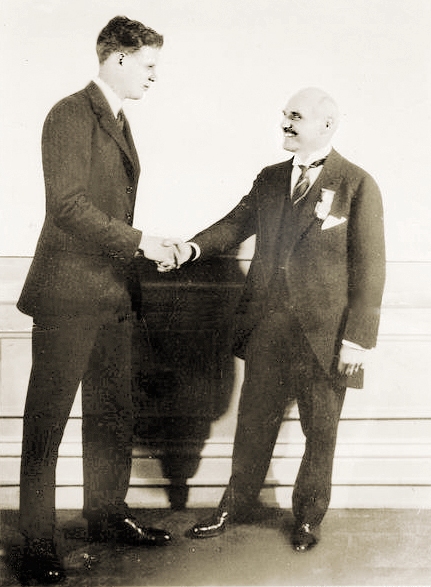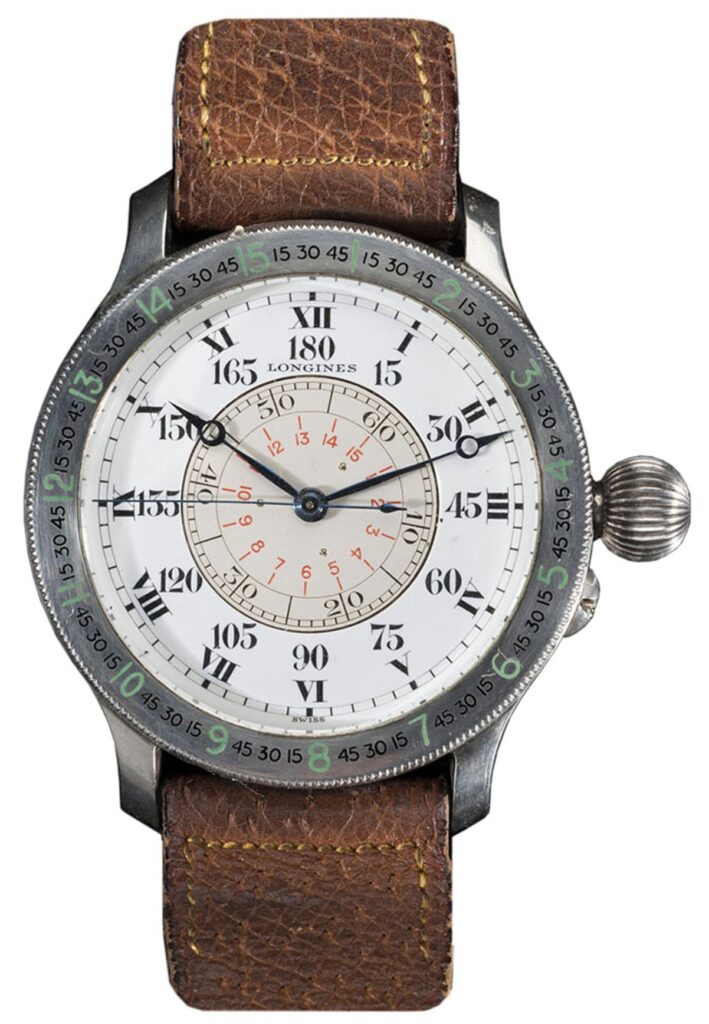The Longines Lindbergh Hour Angle Watch
In 1906, the UK’s tabloid ‘The Daily Mail Newspaper’ – still in operation today, offered £10,000 to the winner of the first flight from London to Manchester, followed by, in 1908, a £1,000 prize for the first flight across the English Channel. Between 1906 and 1930, the paper would reward a prize amount to the individual that performed a particular task or won an event; eighteen opportunities, in all. The prizes are credited with forwarding the map of aviation, early on, with the rewards offered becoming a coveted goal for aviation’s early pioneers.
In America, during that time, the ‘Aero Club of America’, an aviation social club, in New York, hosted a dinner, in 1919, honoring the WW1 flying ace, with 26 aerial victories, Eddie Rickenbacker. Many of the speeches, that night, involved French-American relations including Rickenbacker who stated that he was looking forward to the day that the two countries were linked by air – a reference to the strained relations between America and France following the post-war negotiations at the Paris Peace Conference. The evening’s event inspired, the secretary of the club, Augustus Post, to drew up the rules, in the spirit of The Daily Mail, for a transatlantic flight competition between New York and Paris. The competition rules were given, as such, a $25,000 USD prize (equivalent to over $400,000 USD today) was to be awarded ‘to the first aviator of any Allied Country crossing the Atlantic in one flight, from Paris to New York or New York to Paris’. Seeing an opportunity, French American businessman Raymond Orteig, the owner of the Hotel Lafayette, in New York – a favorite gathering spot for airmen during and after WW1, financed the competition hoping that the Orteig prize would help improve relations, between his adopted and native country, as well encourage air travel and advertise his business, too.

Over the years, various teams assembled and made attempts, on the prize, but all suffered mishaps, many resulting in death. Later on, Orteig and his wife were on holiday, in Pau, France, when he received a message from his son, Raymond Jr, that, a late challenger, American Charles Lindbergh, backed by bankers from St. Louis, Missouri, had departed on his solo transatlantic attempt. Upon hearing the news, Orteig immediately travelled to Paris, arriving just before Lindbergh’s Ryan custom-built, single-engine, single-seat, high-winged monoplane, the Spirit of St. Louis, touched down after 33 hours, 30 minutes of flight travelling a distance of 3,600 miles (5,800 kilometers). Orteig was able to meet Lindbergh, and congratulate him, at the American Embassy on 22 May 1927, in Paris, eight years to the day since he had first funded the prize.
Lindbergh made adjustments, compared to previous groups, that worked. He insisted that unnecessary weight be eliminated, even going so far as to cut the top and bottom off of his flight map. Instead of using a tri-motor, as favored by most other groups, he decided on a single engine aircraft, saving weight, and carried extra fuel as a reserve for emergencies. Lindbergh also dispensed with non-essential equipment like radios, a sextant, and a parachute, although he did take an inflatable raft. His plane was basically glorified scrap metal and his main navigational method was good fortune, at best.
During the same era, in 1927, US Navy officer Philip Van Horn Weems invented a series of navigational devices that were effective, for its time. Basically, he created a radio signal, and it worked, although the technique with radio beacons, at the time, was in its infancy. After Lindbergh completed his celebrated flight, the US Navy assigned Weems to teach him celestial navigation (observing positions of celestial bodies to determine a navigator’s position), for a month, in 1928. This inspired Lindbergh to begin work on an improved system for navigation, in the air, using the basis on what Weems had developed.

The new navigational instrument, a wristwatch, that Lindbergh along with, Swiss watch manufacturer, Longines brought to life, in 1931, was called the Longines Lindbergh Hour Angle Watch. How it works is quite complicated but, essentially, it’s a conjunction between the time, the hour angle hand, a sextant, a nautical almanac and calculations for longitude and altitude to determine a geographical position. This watch allows for an accurate location of the longitude during long-distance flights. As a result, pilots could find their geographic location with great accuracy.
To determine your exact location you need to determine both latitude and longitude. The watch works as follows: Use a sextant ( A doubly reflecting navigation instrument that measures angular distance ) to determine your latitude. To determine your longitude, use the Hour Angle Watch. Set, the watch, to 0 degrees longitude or Greenwich Time Zone (GMT). Greenwich is referred to as civil time. Civil time, is mean time, and is 24 hours long, of course, but to know your exact location you must know the true solar time. Keep in mind, the earth’s orbit around the sun is not perfectly circular every day and has a different length. That result is called true time. The difference between civil time and true time is called the equation of time. The Hour Angle Watch is capable of displaying the time difference that is fundamental to the calculation of a geographic location in hour angles expressed in degrees. Move the reference mark, of the bezel, by negative 3 minutes which is the time difference today, according to the indications of the astronomical almanac. (an almanac published by the United States Naval Observatory and Her Majesty’s Nautical Almanac Office ) Now that the bezel is moved you can then measure the hour angle for civil time, at the Prime Meridian. ( the earth’s zero of longitude, which passes through Greenwich, England ) Add the total of degrees between minute, hour and second hands, together, to determine the hour angle of the Prime Meridian. Once that’s determined, subtract the hour angle of your position and return the bezel to original position. The display, on the watch, now tells us the hour angle of your location. Next, add the total of degrees between minute, hour and second hands in current time to get the hour angle of your present location. Now to determine longitude of your present location, work out the difference between the two hour angles. If the difference number is positive, the number is west of Greenwich. If the difference number is negative, the number is east of Greenwich. Voila, so simple! Right?
Another milestone achievement, Charles Lindbergh worked, with Longines, to produce one of the Swiss brand’s most historically significant timepieces. An intricate instrument, compared to current technology, the Hour Angle is still a remarkable timepiece, even today. Its groundbreaking, rotating-bezel design allowed pilots to calculate their longitude during long-distance flights, thus allowing them to improve their geographic location quickly, efficiently, and accurately.

